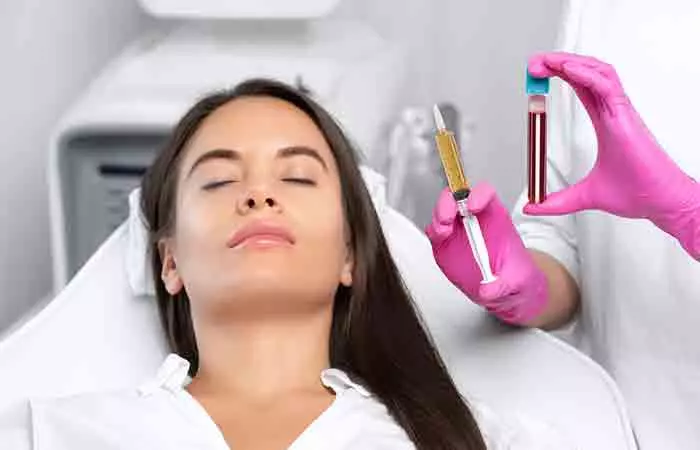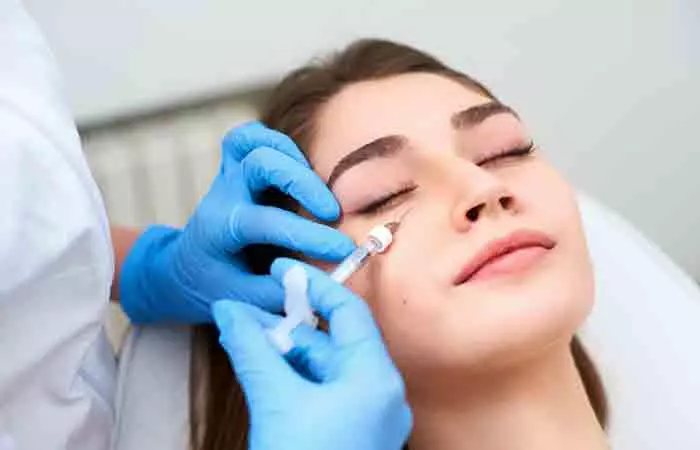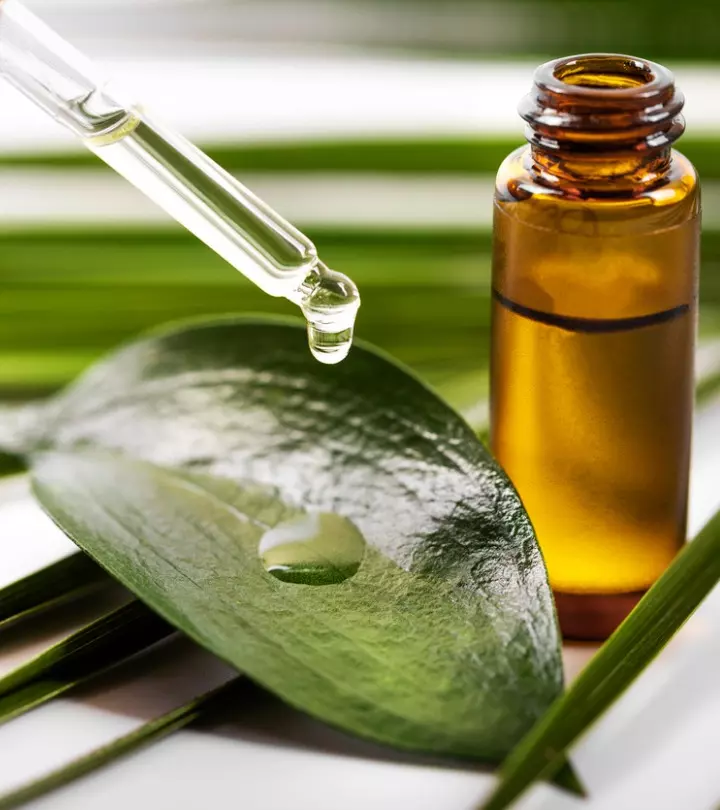PRP Under-Eye Treatment: Benefits And Side Effects
The answer to smooth, supple skin is in your own plasma! This procedure makes the best of it.

Image: Shutterstock
If you have experienced dark under-eye circles at any point in time, you would know how annoying they are. You might have tried various home remedies and scouted the internet for effective solutions to reduce them. But if you are like most of us, nothing seems to work for you. You may have merely resorted to hiding your dark under-eye circles behind layers of makeup.
The solution? The PRP under-eye treatment that may help reduce your dark circles and leave you with a fresh, youthful, and rejuvenated appearance. Intrigued to learn more about this treatment? Read on!
In This Article
What Is PRP (Platelet-Rich Plasma)?
Platelet-rich plasma (PRP) is a concentrated component of blood with high levels of platelets way above the baseline.
PRP contains at least seven growth factors and is used in many medical therapies and beauty procedures.
PRP is produced by isolating plasma from blood and concentrating it. The cytokines and growth factors in PRP promote the healing process and help restore and regenerate damaged tissues (1).
Anecdotal evidence suggests that injecting PRP into damaged skin cells and tissues will help regenerate new cells, fight against wrinkles, and make skin youthful.
Key Takeaways
- Platelet-rich plasma (PRP) has certain growth factors that help restore damaged tissues and skin cells.
- Injecting PRP in problem areas helps improve dermal collagen levels and reduces premature aging signs.
- This non-invasive, painless procedure helps you get soft, supple, and youthful-looking skin.
- You should avoid blood thinners and alcohol before taking PRP injections.
Why Does PRP Work?
PRP is a specific type of treatment falling under the umbrella of regenerative medicine.
PRP is a highly concentrated autologous (obtained from the same individual) solution of plasma. It contains platelets believed to release numerous growth factors and other bioactive molecules with numerous dermatological benefits (2). PRP treatments have been used for a few decades and continue to grow in popularity.
Platelets play a key role in the process of wound healing. They release enzymes when activated. These enzymes initiate clot formation, promote collagen production, and create an environment conducive to healing and rejuvenation. PRP also contains white blood cells that promote a healing response in the body (3).
PRP may rejuvenate the skin when used as an under-eye treatment (4). The production of new, healthy skin under the eyes may eliminate dark under-eye circles. However, more large-scale studies are warranted in this regard.
That said, PRP under-eye treatment does offer certain benefits.
What Are The Benefits Of PRP?
Note that the beauty benefits of PRP treatment are yet to be proven scientifically. However, as per anecdotal evidence, it may smoothen your skin and make it supple. Here are a few potential benefits of this treatment:
1. Your Own Plasma Is Used

Your own blood is used to make the PRP that is used in your treatment. Hence, you need not worry about injecting foreign elements or harmful chemicals into your skin.
2. May Promote Collagen Production

People often experience a drop in their body’s collagen production rate as they hit their late 20s and early 30s. PRP is believed to increase dermal collagen levels (5). It may delay the appearance of fine lines, wrinkles, eye bags and other signs of aging.
3. Is Non-Invasive
A PRP sitting is a totally non-invasive process that doesn’t require you to go under the knife.
4. May Improve Your Skin Tone

Do you have scars on your face that make your skin tone uneven? The PRP treatment may help your skin regenerate and produce healthier skin cells. It may repair the damage caused by stretch marks, injury, and hyper-pigmentation. PRP treatments might improve the overall appearance of your skin. However, more information is warranted in this regard.
5. Is A Painless Procedure

PRP under-eye treatments are minimally invasive and painless procedures. While you would be able to feel the device, you may not experience pain. You may stop using any anti-inflammatory and anti-platelet medicines a few days before your procedure to better promote post-procedural healing.
6. Has Fewer Risks
A PRP treatment is a non-invasive procedure and comes with a very low risk of side effects. No surgery is involved. The recovery time is minimal. There is no risk of plasma rejection either as the plasma is created from your own blood.
7. Offers Long-Lasting Results
The effects of certain skin care treatments last only a few weeks. However, PRP offers you results that can last several months. Collagen production takes some time, and you will continue to experience better skin even after several months. Taking PRP injections every few months can give you sustained results.
 Quick Tip
Quick TipYou can get PRP under-eye treatment for hollow eyes, puffy eyes, eye bags, dark circles, and crow’s feet.
These benefits of a PRP treatment may have got you excited. Would you want to know what happens during a PRP under-eye treatment?
What Happens During A PRP Under-Eye Injection Appointment?

PRP eye treatments can provide optimum hydration, treat your dark circles, rejuvenate your sun-damaged skin, smooth out your fine lines and wrinkles, and eliminate a plethora of other skin issues. This is what you can expect if you choose to go for a PRP treatment.
Step 1
The practitioner first draws one vial of your blood to get your PRP. They will then apply a numbing topical cream under your eyes to make the procedure painless.
Step 2
The blood sample is transferred to a centrifuge after activation. It is spun rapidly to separate your blood’s components. This process takes about 15 minutes. The centrifuge concentrates the platelets to result in a golden-colored liquid, which is your PRP.
Step 3
The PRP is then injected in about 6 to 7 different spots under each eye. This triggers the process of collagen production and skin cell healing.
 Quick Tip
Quick TipYour doctor may use a micro-cannula to inject PRP under the eyes. Since it is not safe to microneedle under the eyes, the doctor may microneedle only around the areas adjacent to the under-eye area.
You can return to your daily activities immediately after undergoing this non-invasive procedure. Most people start seeing positive results in a couple of days. However, noticing the full impact of the PRP treatment may take a little longer.
Peeva, a YouTuber, documented her journey with PRP for under-eye treatment. A week after the treatment, she shares a candid assessment in one of her vlogs: “I feel like when I first got the injection, it looked plump, it looked good. I definitely saw a difference right away, but now that a week has gone by, I kind of feel like I look the same (i).”
Collagen production takes time. You might continue to see improvements in your skin texture even months after your treatment. The effects of your first PRP treatment typically last between four and six months.
Ensure you are well prepared before going for a PRP under-eye treatment procedure.
How To Prepare For A PRP Treatment
A PRP treatment is non-invasive and painless. However, you need to be properly prepared for achieving the best results. You are advised to avoid any other facial treatments in your under-eye region before going for a PRP appointment.
Avoid any blood thinners or medications like Plavix or Aspirin on the day of the treatment. Also avoid consuming alcohol before your session. Go with your face freshly cleansed and with no trace of any makeup.
The PRP is derived from your own blood. Hence, make sure you reach your practitioner’s office on time. The PRP under-eye treatment is a micro-needling process. A topical solution or cream is applied under your eyes a few minutes before the procedure to minimize discomfort. Those with a low pain intolerance might be given a local anesthesia.
What To Expect During A PRP Treatment
While PRP eye treatments are generally said to be painless, they may cause some discomfort. The application of a numbing cream usually nullifies the actual pain. The micro-needling procedure may raise a minute amount of blood to the top of the skin, which the practitioner will wipe off. Some people may experience a little swelling or soreness immediately after the procedure. While many people don’t feel anything at all, some people may find the process mildly uncomfortable.
Proper preparation and aftercare are essential for maximizing the benefits of a PRP treatment and ensuring smooth recovery. Following the recommended guidelines can help protect your skin, minimize side effects, and enhance the overall results of the procedure.
Preparation And Aftercare
Here are essential tips to ensure the best results from your PRP treatment:
- Avoid direct sun exposure for at least 48 hours after the procedure to prevent excessive sun damage on the sensitized area and promote healing.
- Refrain from wearing makeup for 24 hours to minimize irritation and reduce the risk of infection.
- Use a gentle, fragrance-free cleanser to clean your face and avoid scrubbing or using harsh products.
- Stay hydrated and apply a dermatologist-recommended moisturizer to keep the skin nourished and support recovery.
- Avoid strenuous exercise or activities that cause excessive sweating for 24-48 hours to reduce irritation.
- Follow up with your dermatologist for post-treatment care and use any prescribed medicines or ointments as instructed.
With proper care before and after the PRP treatment is done by a certified professional, the results are usually quite satisfactory. However, in some cases, some issues may arise. So, scroll down to explore the potential side effects of PRP treatment so that you can better prepare to manage them.
What Are The Potential Side Effects Of A PRP Treatment?
A PRP treatment is a safe procedure with minimum side effects. However, those with extremely sensitive skin may experience a few side effects. These include:
- Redness: Temporary skin irritation that usually subsides within a few hours.
- Bruising: Minor discoloration at the injection site, fading over a few days.
- Mild pain: Slight discomfort around the treated area, manageable with over-the-counter pain relief.
- Itching: A mild reaction that may occur as the skin heals.
- Swelling: Temporary puffiness in the treated area, typically reducing within 24-48 hours.
- Tenderness: Sensitivity at the injection sites, which diminishes as the skin recovers.
- Puffiness: Slight swelling in the treated area, usually caused by the injection process and inflammation, which subsides within a few days.
- Tiny bumps: Small lumps at the injection points, often resolving on their own.
These side effects usually subside within a few days in most cases.
How Long Does Recovery Take?
In most cases, you can return to your daily activities immediately after getting a PRP under-eye treatment. It usually takes about 2 to 3 hours before you can return to your regular work. Apply ice packs to the treated areas should you experience any inflammation.
Any swelling, bruising, or redness will usually subside within a few days.
How Much Does A PRP Injection Cost?
PRP treatments are highly effective and are priced at a premium. One PRP under-eye session is likely to cost you anywhere between $500 to $2,000, depending upon the location and the practitioner. While it is possible to get it done for rates as low as $300, certain beauty clinics may even charge up to $5,000 for a single sitting.
Are The Results Of PRP Treatments Permanent?
The result of PRP under-eye treatments last longer than many other facial beauty treatments. But do keep in mind that these effects do not last forever. You can expect to see continued improvements in your skin texture for up to 6 to 12 months after a PRP injection. However, you have to repeat your treatment every year to enjoy continued results for a long time.
Infographic: Top 5 Benefits Of PRP Under-Eye Treatment
Dark eye circles can be pretty tough to get rid of. But worry not! You can try PRP (platelet-rich plasma) treatment to treat them. It helps restore and regenerate damaged tissues, rejuvenating your skin in the process. Check out the infographic below to know about the benefits of the PRP treatment.

Illustration: StyleCraze Design Team
PRP under-eye treatment helps regenerate new skin cells and repair damaged cells. It helps produce new cells under the eyes and get rid of dark under-eye circles. Though there is much anecdotal evidence to support the benefits of this anti-aging treatment, there are not enough scientific studies to claim its efficiency. The benefits include delaying the signs of aging, improving your skin tone, and offering long-lasting results. It is a painless process with a very low risk of side effects. You can also return to your work within a few hours of the treatment.
Frequently Asked Questions
Is PRP better than fillers?
Under-eye fillers are another cosmetic option that address similar concerns similar to the PRP therapy. PRP is a safer alternative to getting fillers, which may cause side effects like allergic reactions.
Can I wear makeup after PRP?
Wait for at least three to four days before applying makeup after a PRP treatment.
Is PRP painful on the face?
PRP may cause some discomfort, but you can ask your dermatologist for a numbing cream. After the procedure, you may feel some pain and swelling which goes away after some time.
Is PRP better than Botox?
PRP is safer than Botox, which may cause stiffness and other side effects. Apart from that, the effects of PRP last longer.
Rejuvenate your under-eyes with PRP! Check out this video to learn how this revolutionary treatment can help reduce wrinkles and dark circles for a youthful, glowing look.
Personal Experience: Source
StyleCraze's articles are interwoven with authentic personal narratives that provide depth and resonance to our content. Below are the sources of the personal accounts referenced in this article.
i. Trying Under Eye PRP Injections for the First Timehttps://www.youtube.com/watch?v=s56N9QEi530
References
Articles on StyleCraze are backed by verified information from peer-reviewed and academic research papers, reputed organizations, research institutions, and medical associations to ensure accuracy and relevance. Read our editorial policy to learn more.
- Platelet Rich Plasma: New Insights for Cutaneous Wound Healing Management
https://www.ncbi.nlm.nih.gov/pmc/articles/PMC5872096/ - Systematic review of the use of platelet-rich plasma in aesthetic dermatology
https://pubmed.ncbi.nlm.nih.gov/26205133/ - Platelet Rich Plasma: a short overview of certain bioactive components
https://www.ncbi.nlm.nih.gov/labs/pmc/articles/PMC5329835/ - Assessment of efficacy of platelet-rich plasma (PRP) on infraorbital dark circles and crow’s feet wrinkles
https://pubmed.ncbi.nlm.nih.gov/24641609/ - Histologic Evidence of New Collagen Formulation Using Platelet Rich Plasma in Skin Rejuvenation: A Prospective Controlled Clinical Study
https://www.ncbi.nlm.nih.gov/labs/pmc/articles/PMC5125953/
Read full bio of Dr. Sravya Tipirneni
Read full bio of Arshiya Syeda
Read full bio of Ramona Sinha
Read full bio of Monomita Chakraborty


























Community Experiences
Join the conversation and become a part of our empowering community! Share your stories, experiences, and insights to connect with other beauty, lifestyle, and health enthusiasts.